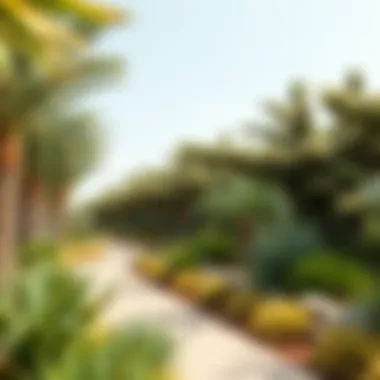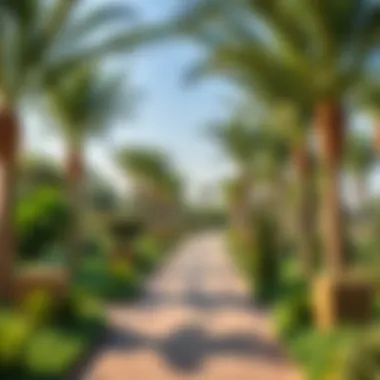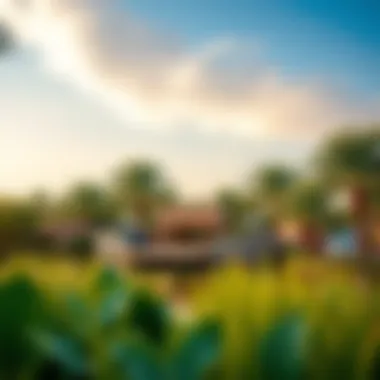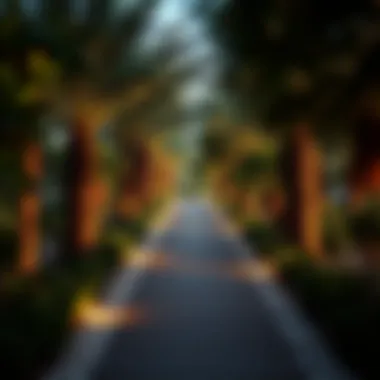Exploring the Nad Al Sheba Mini Forest in Dubai


Intro
Nestled in the vibrant urban landscape of Dubai, the Nad Al Sheba Mini Forest stands as a testimony to the city's commitment to sustainability and ecological balance. This green oasis isn't just a collection of trees and shrubs; it represents a thoughtful initiative to nurture local biodiversity while improving the quality of life for residents. As a city known for its towering skyscrapers and lavish lifestyle, Dubai's foray into urban forestry highlights a growing trend towards greener urban environments.
With a landscape typically dominated by concrete and glass, the introduction of the mini forest serves multiple purposes. It offers not only a habitat for local wildlife but also provides the community a place to connect with nature amidst the hustle and bustle of city life. This initiative has garnered attention from various stakeholders, including investors, homebuyers, and expatriates. As such, it’s essential to explore how this project aligns with broader market trends, enhancing the city’s appeal and livability.
Understanding the significance of such projects helps illuminate the essential question of urban green spaces—how they are reshaping cities while fostering community engagement and sustainable practices. The following sections delve into market trends, living dynamics in Dubai, and how the Nad Al Sheba Mini Forest fits into this picturesque tapestry.
Preface to Nad Al Sheba Mini Forest
The Nad Al Sheba Mini Forest stands as a symbol of Dubai's growing commitment to integrating green spaces within urban environments. Against the backdrop of towering skyscrapers and arid deserts, this mini forest emerges not only as an aesthetic feature but also as an essential lifeline for the community and the local ecosystem. This section delves into the breadth of urban greening initiatives, highlighting their significance, and emphasizes the necessity of green spaces in a rapidly expanding urban framework.
Overview of Urban Greening Initiatives
Urban greening initiatives encompass a multitude of projects aimed at enhancing the livability of cities through the introduction of greenery. In a bustling metropolis like Dubai, these efforts take on added urgency. The Nad Al Sheba Mini Forest is part of a broader effort to combat the effects of urban heat islands, improve air quality, and provide recreational spaces for residents. Projects such as this mini forest underscore the significance of sustainable urban planning, where greenery is not seen merely as a luxury but as a fundamental need.
- Cooling Effects: Urban forests, including the Nad Al Sheba Mini Forest, help lower surrounding temperatures, providing a reprieve from the sweltering heat that can drive inhabitants into air-conditioned isolation.
- Community Wellness: These green patches foster social interaction. Community members can gather, exercise, or simply enjoy nature, significantly contributing to physical and mental well-being.
- Pollinator Support: Through planting native flora, the forest promotes a habitat for pollinators, essential for maintaining ecological balance.
Importance of Green Spaces in Urban Areas
Green spaces have grown in prominence as urban populations burgeon. The importance of these areas cannot be overstated for several reasons:
- Environmental Benefits: Green spaces, like the Nad Al Sheba Mini Forest, enhance biodiversity, support wildlife, and improve air quality. They absorb carbon dioxide while releasing oxygen, a vital process in the fight against climate change.
- Psychological Benefits: Studies have shown that access to green environments can lead to decreased stress levels and enhanced well-being. The serene atmosphere of the mini forest serves as a refuge for both residents and visitors, offering a much-needed escape from city life.
- Aesthetic Appeal: The visual beauty of green areas improves the aesthetic value of neighborhoods, making them not only more attractive to residents but also to potential investors and homebuyers.
"In the heart of bustling urban landscapes, pockets of green can transform lives, offering not just beauty, but a breath of fresh air."
- Economic Boost: Areas with ample green space have been shown to have higher property values. Investors often prioritize neighborhoods with accessible parks and natural spaces when considering real estate opportunities.
By prioritizing the development of urban green spaces like the Nad Al Sheba Mini Forest, Dubai is not merely beautifying the city but is taking a pragmatic approach to addressing the pressing ecological and social challenges faced by its inhabitants. The commitment to preserving and enhancing greenery will have a lasting impact on the landscape of Dubai.
Historical Context of Nad Al Sheba
Understanding the historical context of Nad Al Sheba is crucial to appreciating the evolution of this unique district and its significance in Dubai's urban landscape. Historically, Nad Al Sheba was predominantly a desert area, but it has transformed over the years into a vibrant community hub. This transition is not merely a tale of urban sprawl; it reflects a deeper commitment to sustainability and ecological balance.
Development of Nad Al Sheba District
The development of Nad Al Sheba can be viewed as a microcosm of Dubai’s broader urbanization efforts. Initially, it catered to the needs of local inhabitants with basic infrastructure. However, as Dubai burgeoned into a metropolis, Nad Al Sheba evolved. The area saw new residential projects, retail spaces, and recreational facilities to accommodate an increasingly diverse population. New housing developments like the Nad Al Sheba Villas and the Nad Al Sheba 1–3 neighbourhoods have emerged, providing modern amenities while preserving cultural heritage. This thoughtful evolution has drawn investors and homebuyers alike, who value both modern infrastructure and proximity to green spaces like the mini forest.
The unique aspect of Nad Al Sheba's development is its focus on integrating nature within urban planning. The district’s historical roots are reflected in the balance of dense infrastructures, such as shopping malls and schools, against the backdrop of expansive green areas, including parks and the mini forest that plays a vital role in community life.
Role of Sustainability in Dubai's Urban Planning
Sustainability is not just a buzzword but a fundamental principle guiding Dubai's urban planning initiatives, and Nad Al Sheba stands as a testament to this philosophy. The local government recognizes that green spaces are essential not only for enhancing aesthetic appeal but also for improving environmental quality. The design of residential areas incorporates eco-friendly practices, emphasizing energy efficiency and minimal waste.


The advent of the Nad Al Sheba Mini Forest is a pivotal development aligned with the city’s sustainability goals. It serves as a model for future green projects, demonstrating how urban regions can harmonize with nature. This effort is also complemented by various awareness programs aimed at educating residents about climate change and the significance of biodiversity. Through these initiatives, Nad Al Sheba not only enriches its landscape but also reinforces cultural mindfulness towards sustainable living practices.
"Creating urban green spaces is not merely about planting trees; it’s about sowing the seeds of a sustainable future for generations to come."
In essence, the historical context surrounding Nad Al Sheba profoundly underscores the district’s ongoing transformation into a thriving ecological oasis within one of the world’s fastest-growing cities. As it continues to develop, the commitment to integrating sustainability with urban living remains a cornerstone of its identity.
Design Features of the Mini Forest
The Nad Al Sheba Mini Forest is not just a cluster of trees and greenery; it serves as a well-thought-out example of modern urban environmental design. Aiming to enrich Dubai’s landscape, the design features of this forest play a crucial role in facilitating ecological benefits. The focus on innovative layout, strategic plant selections, and smart water management systems is vital for achieving sustainability and inviting the community to cherish this green haven.
Layout and Plant Selection
The layout of the Nad Al Sheba Mini Forest is a tapestry woven into the urban fabric of Dubai. It is designed with pathways that weave through the greenery, encouraging visitors to explore its serene environment. The thoughtful arrangement allows for easy navigation while fostering a sense of connection with nature.
Regarding plant selection, a mix of species was selected not just for beauty but also for practical reasons. For instance, Acacia and Date Palms are prominent in this design, providing shade, reducing heat, and requiring less water, thus aligning with Dubai’s climate. The juxtaposition of flowering plants and hardy trees creates a vibrant yet harmonious ecosystem.
Integration of Native Species
Integrating native species is an essential pillar in the design of the Mini Forest, contributing to biodiversity and resilience against local pests and disease. Plants such as Ghaf trees, recognized as the UAE's national tree, are included not just for their cultural significance but also for their ecological adaptability.
"By embracing native plants, the Mini Forest promises to thrive with minimal ongoing care, promoting sustainability and reducing maintenance costs."
Incorporating these species fosters a sense of local identity while supporting local wildlife, such as birds and insects. This thoughtful approach not only bolsters habitat integrity but also encourages educational opportunities regarding the environment for visitors, especially children.
Water Management and Irrigation Systems
Water management is crucial in a desert environment, and the Nad Al Sheba Mini Forest has integrated advanced irrigation systems to maximize water efficiency. Drip irrigation technology is employed which conserves water while ensuring that each plant receives sufficient moisture. This system is monitored and adjusted based on real-time data inputs, optimizing water distribution and minimizing wastage.
Additionally, techniques such as rainwater harvesting and retention basins effectively harness this precious resource when it rains, allowing for further sustainability practices. This not only preserves water but also reduces runoff, contributing to the overall health of the local ecosystem.
By understanding and appreciating the design features of the Mini Forest, one can grasp its significance as part of larger urban initiatives to create livable, sustainable spaces in Dubai. It exemplifies how thoughtful design can lead to essential ecological improvements, ultimately enhancing the quality of life for residents and the natural world alike.
Ecological Benefits of the Forest
The Nad Al Sheba Mini Forest serves not just as a peaceful retreat for city dwellers but as a crucial ecosystem in an urban landscape that often lacks sufficient greenery. Its establishment highlights the necessity for ecological awareness and community involvement in maintaining local biodiversity. The forest contributes to addressing several significant environmental challenges faced by urban areas, particularly in terms of biodiversity support, climate regulation, and air quality improvement.
Biodiversity Support
A lush mini forest like Nad Al Sheba is essential for fostering biodiversity. The unique array of native plants in the forest provides habitats for various species, including birds, insects, and other wildlife. This support of biodiversity is not merely a byproduct of greenery but a vital function that ensures ecological balance. In an environment otherwise dominated by concrete and steel, even a small forest can act like an island of life, connecting various organisms that might otherwise struggle to survive.
- Plant Diversity: The forest incorporates several native species such as Ghaf trees and various shrubs adapted to the arid climate. These plants provide food and shelter for local wildlife.
- Wildlife Attraction: Whether it's native birds building nests or pollinators like bees, the presence of diverse flora attracts a rich variety of fauna. This, in turn, plays a role in promoting a thriving ecosystem right in the heart of Dubai.
"A mini forest can serve as a refuge for wildlife, allowing species to flourish in an urban landscape that often composes barriers rather than bridges."
Climate Regulation


Climate regulation is another critical benefit offered by the Nad Al Sheba Mini Forest. Urban areas tend to experience a phenomenon known as the urban heat island effect, where cities become significantly warmer than their rural counterparts due to human activities. Trees play a vital role in mitigating this effect through shading and evapotranspiration. By absorbing sunlight and releasing moisture, the forest cools the surrounding area.
- Temperature Moderation: Especially during the sweltering summer months, the shade from the trees can drastically lower temperatures in the mini forest and surrounding areas.
- Carbon Sequestration: Trees are natural carbon sinks, absorbing carbon dioxide, which is crucial for combating climate change. As such, the mini forest contributes to the reduction of greenhouse gases in the atmosphere.
Air Quality Improvement
The air quality in rapidly urbanizing areas can often resemble a mixed bag of pollutants, with traffic and construction noise drowning out the softer sounds of nature. The Nad Al Sheba Mini Forest works to tackle this issue directly. Plants filter the air and absorb carbon dioxide, releasing oxygen and purifying the atmosphere.
- Natural Filtration: Through the process of photosynthesis, the trees utilize carbon dioxide, effectively lowering its concentration in the air. This process also helps in filtering out airborne pollutants and particulates, providing a cleaner breathing environment.
- Health Benefits: Improved air quality affects overall health positively. Residing near or within reach of green spaces has been linked to benefits such as reduced stress levels and improved respiratory health.
In summation, the ecological benefits provided by the Nad Al Sheba Mini Forest extend well beyond its picturesque environment. This forest plays a pivotal role in promoting biodiversity, regulating the climate, and purifying the air in an urban setting. The ongoing support for such initiatives is essential, signaling a progressive step towards sustainable urban living in areas like Dubai.
Community Engagement and Social Impact
Community-driven initiatives play an essential role in the Nad Al Sheba Mini Forest. They ensure that the benefits of urban green spaces like this one resonate with the locals, fostering not just environmental awareness but also social connectivity. When residents engage in such projects, they take ownership of the green space, which cultivates a sense of pride and responsibility. This bond is invaluable as it nurtures a deeper appreciation for sustainable practices while encouraging participation in ongoing and future programs.
Involvement of Local Residents
The participation of local residents is pivotal to the success of the Nad Al Sheba Mini Forest. From planting trees to maintaining the landscape, community involvement makes the forest a collective project rather than just a government initiative. Residents can volunteer during tree planting events or help with ongoing maintenance tasks. This hands-on approach allows individuals to witness the growth and evolution of their environment firsthand.
Moreover, local groups and youth organizations regularly liaise with the forest's management to conduct programs and activities. For instance, some schoolchildren have taken part in educational outings that not only enlighten them about ecology but are also practical experiences where they can contribute their efforts toward nurturing the forest.
Educational Programs and Workshops
Educational initiatives are fundamental in promoting understanding and appreciation of the forest’s ecological value. These programs aim to inform attendees about biodiversity, sustainable practices, and the importance of green spaces in urban settings. Workshops can vary from environmental conservation techniques to gardening practices that residents can implement in their own homes.
Additionally, sessions on permaculture or wildlife conservation might be organized for those interested. Through these educational programs, participants not only gain knowledge but also build a community of like-minded individuals who can support each other's efforts towards sustainability. Data suggests that when people are informed and involved, they are far more likely to act in favor of preserving their local environments.
Promoting Mental Health and Wellbeing
Urban green spaces like the Nad Al Sheba Mini Forest serve as a sanctuary for mental well-being. Research indicates that regular exposure to nature has a profound effect on mental health, reducing stress and enhancing overall life satisfaction. By encouraging people to engage in the natural environment—be it through walking, meditation, or simple storytelling sessions—this forest plays a significant role in fostering a peaceful coexistence with nature.
Moreover, social gatherings, such as open-air movie nights or yoga classes in the forest, create a community atmosphere where people connect, share, and support one another. Such communal activities reinforce social ties, contributing to a well-rounded sense of belonging. The psychological benefits brought about by an accessible and vibrant green haven cannot be overstated; as the adage goes, "A friend in need is a friend indeed," and the forest serves as an ally for those seeking respite from the hustle and bustle of daily life.
"Green spaces in cities have a role in improving mental health and providing a friendly environment for communal living."
The Nad Al Sheba Mini Forest stands not only as a simple collection of trees but as a vital community hub that embraces involvement, education, and well-being. Through fostering engagement, it transforms lives and promotes a sustainable future.
Challenges in Establishing Urban Green Spaces
Urban green spaces play a crucial role in enhancing the livability of cities. However, establishing these areas, like the Nad Al Sheba Mini Forest, comes with its own set of challenges that require careful consideration. This section explores the intricacies of balancing development and conservation, as well as the critical aspect of funding and resource allocation in creating such communal oases.
Balancing Development and Conservation
Urban areas are constantly under pressure from rapid development. With the influx of investors and an ever-growing population, the demand for housing and infrastructure can sometimes overshadow the need for green spaces. It becomes imperative to strike a balance between economic growth and the conservation of natural environments.
Incorporating green spaces in urban planning should not be viewed as an afterthought. Instead, developers and planners must explore innovative methods to integrate forests, parks, and gardens within the dense urban fabric.
For instance, vertical gardens and rooftop parks have emerged as viable solutions in cities facing space constraints. These strategies can mitigate urban heat island effects while providing essential greenery.


"The challenge lies not only in the planning phase but also in ensuring that these spaces are maintained, cherished, and utilized by the local community."
Funding and Resource Allocation
A significant hurdle in establishing green spaces is securing sufficient funding. Urban greenery initiatives often require considerable financial backing, which can be a daunting task. At times, local governments may prioritize other pressing needs such as healthcare or infrastructure, leaving little room in budgets for parks and green initiatives.
For the Nad Al Sheba Mini Forest, engaging private investors could pave the way for funding. Collaborations with environmental organizations and community stakeholders can also contribute to resource allocation. Initiatives such as crowdfunding, grants from governmental bodies, or partnerships with corporations seeking corporate social responsibility can provide much-needed financial support.
Furthermore, an effective model for funding urban green projects could involve seasonal fundraising events, where the community comes together not only to raise money but also to engage directly with their environment.
The active involvement of the community not only enhances local ownership but also reinforces the importance of maintaining and developing these spaces in the long run.
In summary, while the journey toward establishing urban green spaces like the Nad Al Sheba Mini Forest is fraught with challenges, thoughtful approaches to balancing development with conservation and innovative funding strategies can lead to the successful creation of sustainable green havens.
Future Projects and Expansion Plans
The Nad Al Sheba Mini Forest is more than just a small patch of green in a sprawling desert city; it represents a vision for how urban spaces can evolve to become more sustainable and friendly to nature. Understanding future projects and expansion plans is critical, not just for this miniature forest itself, but for the entire framework of urban ecology in Dubai and beyond. The push towards a larger green network is about fusing together existing green belts, parks, and natural reserves, which will not only beautify the city but also enrich its ecological footprint.
Creating a cohesive ecosystem means relishing in the benefits these projects bring. For example, they lead to cooler urban temperatures that result in lower energy costs during the sweltering summer months. Furthermore, an integrated network of parks can improve biodiversity, providing essential habitats for various species. The implications extend to increased property values in the vicinity, fostering a thriving environment for investors and homebuyers alike.
Vision for a Larger Green Network
The concept of a broader green network involves expanding the mini forest into a series of interconnected parks and green spaces that would serve the community at large. Just imagine walking through paths that allow easy access to nature right from your backyard, or having picnic areas that seamlessly connect with walking trails and nature reserves.
- Accessibility: Residents could enjoy easy access to these green spaces via well-designed pedestrian paths, further encouraging outdoor activities.
- Local Flora: By including more native plants and trees, the larger network can mimic the natural ecosystems previously found in the region, elevating biodiversity.
- Community Accessibility: Projects will likely focus on areas that are currently underserved, promoting mental wellbeing and social interaction.
The ultimate goal is to establish a green corridor that can connect individuals not only to each other but also to the environment. This interconnectedness will create a cycle of life that nurtures community engagement and ecological literacy.
Collaboration with Environmental Organizations
One of the pivotal ingredients for the success of the future projects surrounding Nad Al Sheba is the partnership with various environmental organizations. Nonprofits and international environmentalists bring extensive experience and resources to the table, ensuring activities are sustainable and impactful.
Engaging with these organizations can facilitate:
- Knowledge Exchange: They offer invaluable insights into best practices, climate adaptations, and innovative gardening techniques that can be adapted for urban settings.
- Funding Opportunities: Many environmental organizations can provide funding specifically targeted at sustainable urban re-greening efforts, alleviating some of the financial burdens from local government.
- Awareness Campaigns: Collaborative efforts can amplify awareness efforts about sustainability practices, leading to increased community engagement.
For instance, partnering with groups like the Dubai Green Council could further provide a platform for workshops and educational programs targeted at the community. Together, they can work on initiatives that solidify the role of urban green spaces in enhancing quality of life, setting a national example on how desert cities can shift towards sustainability through adaptive practices linked to the land’s heritage.
"Sustainability is not just a goal; it’s a journey toward making better choices for our home here on Earth."
In closing, the future of Nad Al Sheba Mini Forest and its expansion network will hinge on strategic planning and community involvement. It stands as an opportunity to redefine urban living by embracing nature in a fundamental way.
Culmination: The Long-Term Impact of Nad Al Sheba Mini Forest
The Nad Al Sheba Mini Forest stands as not just a patch of greenery amid the urban expanse of Dubai but rather as a beacon for sustainable practices moving forward. The forest's significance transcends its aesthetic appeal—it's a living testament encouraging the destillation of ecological principles into everyday city life. As urban spaces continue to burgeon, the increasin need for sustainable solutions becomes ever more critical. Here, the mini forest serves as a prime example of how green spaces can efficiently meld into the architectural fabric of bustling metropolises.
Sustainability as a Model for Future Initiatives
In the context of urban development, sustainability isn’t merely an option; it’s an obligation towards future generations. By observing the well-implemented principles at Nad Al Sheba, various stakeholders can derive important lessons. For one, the method of selecting indigenous plant species fosters a self-sustaining environment that requires minimal maintenance. This approach not only reduces water consumption but also encourages local wildlife, thus promoting biodiversity that is often compromised in urban settings.
Moreover, the water management systems incorporated in the forest's design showcase how efficiency can be attained without sacrificing visual or ecological benefits. The ability to recycle water means that resources are optimally utilized, potentially providing a model for similar projects in mega cities around the globe. This design could inspire developers aiming to align with global sustainability goals, proving that it’s indeed possible to integrate fruitful greenery without overlapping with construction and infrastructure needs.
"Sustainability must be woven into the very fabric of our urban planning—it's not just a trend, but a necessity."
Looking ahead, the careful planning and execution that have characterized the Nad Al Sheba Mini Forest hold invaluable lessons—a reminder that with vision and commitment, urban growth can harmonize with environmental responsibility.







